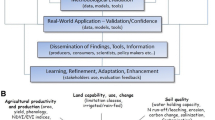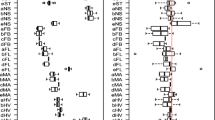Abstract
Precision agriculture for banana crops has been little investigated so far. The main difficulty to implement precision agriculture methods lies in the asynchronicity of this crop: after a few cycles, each plant has its own development stage in the field. It results in a diversity of the phenological stages within a field and also a continuous production of bananas over time. Therefore, maps of agronomic interest derived from plant responses are difficult to produce using existing methods. This study proposes a mapping approach that handles the diversity of phenological stages and the temporal continuity of production. It explores the feasibility of applying this general approach to a plant response parameter which is the time between flowering and maturity (time to harvest) of banana denoted tfm. The tfm gives an insight into the spatial distribution of vigour. The study was conducted using a large database (more than 395 000 observations) generated by two commercial farms in 2015 and 2016 in Cameroon. The temporal variability of tfm, which is induced by meteorological and operational constraints, and the spatial variability, which is assumed to be due to environmental factors, was assessed by decomposing the tfm variance. This method allowed mapping of the effect of the temporal variability as well as the effect of agri-environmental variables on tfm using a block kriging method. Spatial structures highlighted by this decomposition either at the farm level or at the field level, suggest that the map of the effect of environmental factors on tfm could be used to support agronomic decisions. This idea is reinforced by the identification of factors explaining the environmental variability of tfm and by the temporal stability of the spatial structures.











Similar content being viewed by others
References
Acevedo-Opazo, C., Tisseyre, B., Ojeda, H., & Guillaume, S. (2010). Spatial extrapolation of the vine (Vitis vinifera L.) water status: A first step towards a spatial prediction model. Irrigation Science,28(2), 143. https://doi.org/10.1007/s00271-009-0170-3.
Bachmaier, M., & Backes, M. (2008). Variogram or semivariogram? Understanding the variances in a variogram. Precision Agriculture,9(3), 173–175. https://doi.org/10.1007/s11119-008-9056-2.
Bakhsh, A., Jaynes, D. B., Colvin, T. S., & Kanwar, R. S. (2000). Spatio-temporal analysis of yield variability for a corn-soybean field in Iowa. Transactions of the ASAE,43(1), 31. https://doi.org/10.13031/2013.2684.
Baume, O., Skøien, J. O., Heuvelink, G. B., Pebesma, E. J., & Melles, S. J. (2011). A geostatistical approach to data harmonization—Application to radioactivity exposure data. International Journal of Applied Earth Observation and Geoinformation,13(3), 409–419. https://doi.org/10.1016/j.jag.2010.09.002.
Bramley, R. G. V. (2005). Understanding variability in winegrape production systems 2. Within vineyard variation in quality over several vintages. Australian Journal of Grape and Wine Research,11(1), 33–42. https://doi.org/10.1111/j.1755-0238.2005.tb00277.x.
Brenning, A., Koszinski, S., & Sommer, M. (2008). Geostatistical homogenization of soil conductivity across field boundaries. Geoderma,143(3–4), 254–260. https://doi.org/10.1016/j.geoderma.2007.11.007.
Bugaud, C., & Lassoudière, A. (2005). Variabilité de la durée de vie verte des bananes en conditions réelles de production (Variability of the green life of bananas in real conditions of production). Fruits,60(4), 227–236. https://doi.org/10.1051/fruits:2005029.
Clifford, P., Richardson, S., & Hemon, D. (1989). Assessing the significance of the correlation between two spatial processes. Biometrics, 45(1), 123–134. https://doi.org/10.2307/2532039.
Colaço, A. F., Trevisan, R. G., Molin, J. P., & Rosell-Polo, J. R. (2017). A method to obtain orange crop geometry information using a mobile terrestrial laser scanner and 3D modeling. Remote Sensing,9(8), 763. https://doi.org/10.3390/rs9080763.
Cottin, R., Melin, P., & Ganry, J. (1987). Modélisation de la production bananière. Influence de quelques paramètres en Martinique (Modeling of banana production. Influence of some parameters in Martinique). Fruits,42(12), 691–701.
Diacono, M., Castrignanò, A., Troccoli, A., De Benedetto, D., Basso, B., & Rubino, P. (2012). Spatial and temporal variability of wheat grain yield and quality in a Mediterranean environment: A multivariate geostatistical approach. Field Crops Research,131, 49–62. https://doi.org/10.1016/j.fcr.2012.03.004.
Diacono, M., Rubino, P., & Montemurro, F. (2013). Precision nitrogen management of wheat. A review. Agronomy for Sustainable Development,33(1), 219–241. https://doi.org/10.1007/s13593-012-0111-z.
Faostat. 2013. Food and Agriculture Organization of the United Nations. Retrieved August, 2018, from http://faostat.fao.org/.
Freitas, A. S., Pozza, E. A., Alves, M. C., Coelho, G., Rocha, H. S., & Pozza, A. A. A. (2016). Spatial distribution of Yellow Sigatoka Leaf Spot correlated with soil fertility and plant nutrition. Precision Agriculture,17(1), 93–107. https://doi.org/10.1007/s11119-015-9409-6.
Ganry, J., & Meyer, J. P. (1975). Recherche d’une loi d’action de la température sur la croissance des fruits du bananier (Research on a law governing the effect of temperature on the growth of banana fruits). Fruits,30(6), 375–392.
Gomez, K. A., & De Datta, S. K. (1971). Border effects in rice experimental fields I. Unplanted borders. Experimental Agriculture,7(1), 87–92. https://doi.org/10.1017/s0014479700004816.
Hotegni, V. N. F., Lommen, W. J., Agbossou, E. K., & Struik, P. C. (2014). Heterogeneity in pineapple fruit quality results from plant heterogeneity at flower induction. Frontiers in plant Science,5(670), 1–13. https://doi.org/10.3389/fpls.2014.00670.
Jullien, A., Chillet, M., & Malézieux, E. (2008). Pre-harvest growth and development, measured as accumulated degree days, determine the post-harvest green life of banana fruit. The Journal of Horticultural Science & Biotechnology,83(4), 506–512. https://doi.org/10.1080/14620316.2008.11512414.
Kaspar, T. C., Colvin, T. S., Jaynes, D. B., Karlen, D. L., James, D. E., Meek, D. W., et al. (2003). Relationship between six years of corn yields and terrain attributes. Precision Agriculture,4(1), 87–101. https://doi.org/10.1023/a:1021867123125.
Krige, D. G. (1951). A statistical approach to some basic mine valuation problems on the Witwatersrand. Journal of the Southern African Institute of Mining and Metallurgy,52(6), 119–139.
Lassoudière, A. (2007). Le bananier et sa culture. Versailles, France: Editions QUAE.
Leroux, C., Jones, H., Pichon, L., Guillaume, S., Lamour, J., Taylor, J., et al. (2018). GeoFIS: An open source, decision-support tool for precision agriculture data. Agriculture,8(6), 1–21. https://doi.org/10.3390/agriculture8060073.
Leroux, C., Jones, H., Pichon, L., Taylor, J., & Tisseyre, B. (2019). Automatic harmonization of heterogeneous agronomic and environmental spatial data. Precision Agriculture,20(6), 1211–1230.
MacKenzie, S. J., Xiao, C. L., Mertely, J. C., Chandler, C. K., Martin, F. G., & Legard, D. E. (2003). Uniformity of strawberry yield and incidence of Botrytis fruit rot in an annual production system. Plant Disease,87(8), 991–998. https://doi.org/10.1094/pdis.2003.87.8.991.
McBratney, A. B., & Webster, R. (1986). Choosing functions for semi-variograms of soil properties and fitting them to sampling estimates. European Journal of Soil Science,37(4), 617–639. https://doi.org/10.1111/j.1365-2389.1986.tb00392.x.
Oliver, M. A., & Webster, R. (2014). A tutorial guide to geostatistics: Computing and modelling variograms and kriging. CATENA,113, 56–69. https://doi.org/10.1016/j.catena.2013.09.006.
Osorio, F., & Vallejos, R. (2014). SpatialPack: Package for analysis of spatial data. Retrieved January, 2017, from http://cran.r-project.org/package=SpatialPack/.
Pebesma, E. J. (2004). Multivariable geostatistics in S: The gstat package. Computers & Geosciences,30(7), 683–691. https://doi.org/10.1016/j.cageo.2004.03.012.
Pebesma, E. J., & Bivand, R. S. (2005). Classes and methods for spatial data in R. R News,5(2), 9–13. https://doi.org/10.1007/978-1-4614-7618-4_2.
Plant, R. E. (2012). Spatial data analysis in ecology and agriculture using R. Boca Raton, Florida, USA: CRC Press. https://doi.org/10.1007/s13253-012-0112-z.
Quebrajo, L., Pérez-Ruiz, M., Rodriguez-Lizana, A., & Agüera, J. (2015). An approach to precise nitrogen management using hand-held crop sensor measurements and winter wheat yield mapping in a mediterranean environment. Sensors,15(3), 5504–5517. https://doi.org/10.3390/s150305504.
R Development Core Team (2008). R: A language and environment for statistical computing. R Foundation for Statistical Computing, Vienna, Austria. ISBN 3-900051-07-0. http://www.R-project.org.
Santesteban, L. G., Guillaume, S., Royo, J. B., & Tisseyre, B. (2013). Are precision agriculture tools and methods relevant at the whole-vineyard scale? Precision Agriculture,14(1), 2–17. https://doi.org/10.1007/s11119-012-9268-3.
Skøien, J. O., Baume, O. P., Pebesma, E. J., & Heuvelink, G. M. (2010). Identifying and removing heterogeneities between monitoring networks. Environmetrics: The Official Journal of the International Environmetrics Society,21(1), 66–84. https://doi.org/10.1002/env.985.
Stoorvogel, J. J., & Orlich, R. A. (2000). An integrated system for precision agriculture in bananas. In Proceedings of the 5th International Conference on Precision Agriculture, (pp. 1–14). Madison, WI, USA: American Society of Agronomy.
Taylor, J. A., & Bates, T. R. (2012). Sampling and estimating average pruning weights in Concord grapes. American Journal of Enology and Viticulture,63(4), 559–563. https://doi.org/10.5344/ajev.2012.12069.
Tchuenteu, F., & Marie, P. (1998). Cartographie des sols de bananeraies du groupe SPNP-SBM-PHP (Mapping of banana plantation soils of the SPNP-SBM-PHP group). Retrieved January, 2017, from https://agritrop.cirad.fr/574908/1/document_574908.pdf.
Thorp, K. R., Hunsaker, D. J., French, A. N., Bautista, E., & Bronson, K. F. (2015). Integrating geospatial data and cropping system simulation within a geographic information system to analyze spatial seed cotton yield, water use, and irrigation requirements. Precision Agriculture,16(5), 532–557. https://doi.org/10.1007/s11119-015-9393-x.
Tisseyre, B., Geraudie, V., & Saurin, N. (2015). How to define the size of a sampling unit to map high resolution spatial data? In J.V. Stafford (Ed.) Precision agriculture’15 Proceedings of the 10th European Conference on Precision Agriculture (pp. 101–113). Wageningen, The Netherlands: Wageningen Academic Publishers. https://doi.org/10.3920/978-90-8686-814-8_51
Tixier, P., Malezieux, E., & Dorel, M. (2004). SIMBA-POP: A cohort population model for long-term simulation of banana crop harvest. Ecological Modelling,180(2), 407–417. https://doi.org/10.1016/j.ecolmodel.2004.04.028.
Torres-Sánchez, J., López-Granados, F., & Peña, J. M. (2015). Mapping olive-tree geometric features from 3d models generated with an unmanned aerial vehicle. In J.V. Stafford (Ed.) Precision agriculture’15 Proceedings of the 10th European Conference on Precision Agriculture (pp. 89–99). Wageningen, The Netherlands: Wageningen Academic Publishers. https://doi.org/10.3920/978-90-8686-814-8_39
Turner, D. W., Fortescue, J. A., & Thomas, D. S. (2007). Environmental physiology of the bananas (Musa spp). Brazilian Journal of Plant Physiology,19(4), 463–484. https://doi.org/10.1590/s1677-04202007000400013.
Urretavizcaya, I., Santesteban, L. G., Tisseyre, B., Guillaume, S., Miranda, C., & Royo, J. B. (2014). Oenological significance of vineyard management zones delineated using early grape sampling. Precision Agriculture,15(1), 111–129. https://doi.org/10.1007/s11119-013-9328-3.
Verdugo-Vásquez, N., Acevedo-Opazo, C., Valdés-Gómez, H., Araya-Alman, M., Ingram, B., de Cortázar-Atauri, I. G., et al. (2016). Spatial variability of phenology in two irrigated grapevine cultivar growing under semi-arid conditions. Precision Agriculture,17(2), 218–245. https://doi.org/10.1007/s11119-015-9418-5.
Vinatier, F., Tixier, P., Le Page, C., Duyck, P. F., & Lescourret, F. (2009). COSMOS, a spatially explicit model to simulate the epidemiology of Cosmopolites sordidus in banana fields. Ecological Modelling,220(18), 2244–2254. https://doi.org/10.1016/j.ecolmodel.2009.06.023.
Webster, R., & Oliver, M. A. (1992). Sample adequately to estimate variograms of soil properties. Journal of Soil Science,43(1), 177–192. https://doi.org/10.1111/j.1365-2389.1992.tb00128.x.
Whelan, B. M., & McBratney, A. B. (2000). The “null hypothesis” of precision agriculture management. Precision Agriculture,2(3), 265–279. https://doi.org/10.1023/a:1011838806489.
Zanella, V., Ortiz, B. V., Thorp, K., Morari, F., Mosca, G., & Hoogenboom, G. (2015). Combining crop sensing and simulation modeling to assess within-field corn nitrogen stress. In J.V. Stafford (Ed.) Precision agriculture’15 Proceedings of the 10th European Conference on Precision Agriculture (pp. 165–177). Wageningen, The Netherlands: Wageningen Academic Publishers. https://doi.org/10.3920/978-90-8686-814-8_48
Acknowledgements
The authors would like to thank the Compagnie Fruitière and Plantation du Haut Penja, in particular Alain Normand, Gilbert Bonnefont, Aurélien Pugeaux and Patrick Vieil who provided the data and supported the study. They also would like to thank all the field workers who were involved in the data collection.
Author information
Authors and Affiliations
Corresponding author
Additional information
Publisher's Note
Springer Nature remains neutral with regard to jurisdictional claims in published maps and institutional affiliations.
Electronic supplementary material
Below is the link to the electronic supplementary material.
Rights and permissions
About this article
Cite this article
Lamour, J., Naud, O., Lechaudel, M. et al. Spatial analysis and mapping of banana crop properties: issues of the asynchronicity of the banana production and proposition of a statistical method to take it into account. Precision Agric 21, 897–921 (2020). https://doi.org/10.1007/s11119-019-09700-7
Published:
Issue Date:
DOI: https://doi.org/10.1007/s11119-019-09700-7




